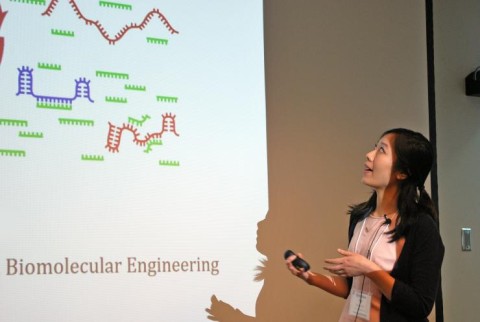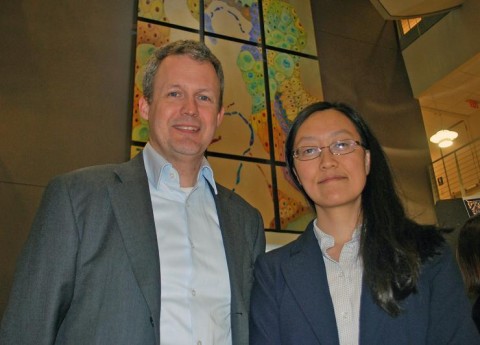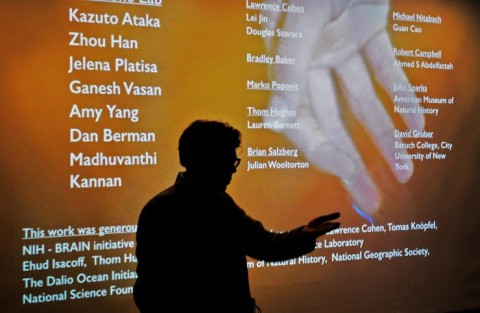



The 25th annual Suddath Symposium was devoted, for the first time, to neuroscience research. The two-day event (Feb. 21-22) featured speakers from across the country and both sides of the Atlantic – some of the world’s thought-leaders in the budding field.
But it was a young, recently-minted Ph.D. in the area of chemical and biomolecular engineering who took center stage as the event unfolded. Suddath Award winner Christine He, from the lab of Petit Institute researcher Martha Grover, and with one foot out the door, delivered the first presentation of the symposium, and it had nothing to do with neuroscience.
Such is the nature of this well-attended, wide-ranging event. At the end of every calendar year, a doctoral student is selected as the Suddath Award winner, for having demonstrated a significant research achievement in biology, biochemistry, or biomedical engineering. In addition to the $1,000 first prize, the winner also is invited to present his or her research at the annual Suddath Symposium, regardless of whether or not it matches with the symposium’s selected theme.
He, the seventh woman in a row to earn the honor, presented her research project (entitled, “Building a Model Prebiotic Nucleic Acid Replication Cycle in Viscous Enivornments.”). And even though it was not about neuroscience, her presentation – delivered with the calmness of a seasoned pro – drew a packed room.
“I wasn’t really sure what to expect, so I was very pleased with the turnout,” said He, who opened the two-day symposium on Tuesday, then caught a plane Wednesday morning for her new assignment as a post-doc at the University of California-Berkeley, where she’ll be working in the lab of Jennifer Doudna, the scientist who co-invented pioneering new technology for editing genes, called CRISPR-Cas9.
“This is going to be exciting,” He said Tuesday evening, shortly before leaving for the next phase of her life.
Meanwhile, the neuroscientists and neuro-engineers kept packing the Suddath Room on the ground floor of the Petit Institute.
“This is an exciting time in neuroscience. Things are rapidly expanding in the field, especially here at Georgia Tech,” said Garrett Stanley, co-director of this year’s symposium with Hang Lu. Both are Petit Institute researchers.
Stanley is professor in the Wallace H. Coulter Department of Biomedical Engineering at Georgia Tech and Emory, and Lu is a professor in Georgia Tech’s School of Chemical and Biochemical Engineering), both of them busily engaged in neuroscience research and members of the GTNeuro steering committee (GTNeuro is the umbrella organization of Georgia Tech’s neuro-community).
Featured researchers from out of town were Eve Marder (Brandeis University), Gero Miesenböck (University of Oxford, England), Vincent Pieribone (Yale University), William Shafer (Cambridge University, England), and Mark Schnitzer (Stanford University).
Researchers from the Atlanta area were Gordon Berman (Emory University), Bilal Haider (Coulter Department at Emory/Georgia Tech), Liang Han (Georgia Tech), Ravi Kane (Georgia Tech), Paul Katz (Georgia State University), Robert Liu (Emory), Patrick McGrath (Georgia Tech), Annabelle Singer (Coulter Department at Emory/Georgia Tech), Sam Sober (Emory), Zhexing Wen (Emory), and Larry Young (Emory).
“The goal is to highlight some of the excitement of neuroscience and neuro-technology from our community, but also to talk to non-neuroscientists and get them excited,” said Stanley. “So we brought in people from across the U.S. and abroad, an exciting array of speakers. I think the interest and attendance at this symposium is a reflection of the growing interest in the field. And really, we’re just getting started.”
LINKS:
2017 Suddath Symposium program
CONTACT:
Jerry Grillo
Communications Officer II
Parker H. Petit Institute for
Bioengineering and Bioscience
Jerry Grillo
Communications Officer II
Parker H. Petit Institute for
Bioengineering and Bioscience
